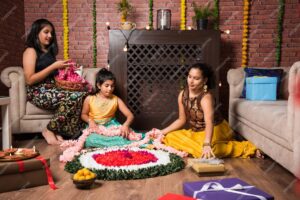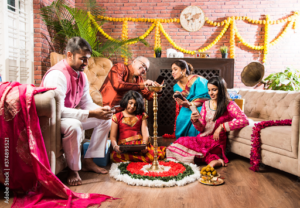Cultural Harmony: Navigating the Essentials of Organizing an Indian Pooja in Your Home

India, known for its rich cultural tapestry, is home to a myriad of traditions and rituals that have been passed down through generations.
One such integral aspect of Indian culture is the practice of Pooja, a ritualistic worship that holds immense significance in Hindu households.
Organizing a Pooja at home requires attention to detail, cultural sensitivity, and a deep understanding of the customs involved.
To buy all the necessary decor items for your Pooja, you can visit LoveNspire, a one-stop destination for authentic and aesthetically pleasing accessories that enhance the spiritual ambiance of your space.
In this article, we will explore the essentials of organizing an Indian Pooja, offering a guide for those interested in embracing and celebrating this cultural tradition.
Understanding the Significance of Pooja
Pooja, derived from the Sanskrit word ‘Puja,’ translates to reverence, homage, or adoration. It is a ceremonial act of showing devotion to a deity through various rituals, prayers, and offerings.
Poojas are performed on various occasions such as festivals, auspicious days, and personal milestones, acting as a means to connect with the divine and seek blessings for oneself and loved ones.
Choosing the Right Time and Occasion
Before diving into the intricate details of organizing a Pooja, it is crucial to choose an auspicious time and occasion.
Consult a Hindu calendar or a local priest to determine the most favorable date and time for the Pooja. This step sets the foundation for a spiritually charged and harmonious ceremony.
Setting Up the Sacred Space: Pooja Room Essentials
Creating a dedicated space for the Pooja is essential to maintain the sanctity of the ritual. Here are the key elements to consider when setting up the sacred space:
1. Pooja Mandir or Altar
Invest in a Pooja mandir or altar, a designated space to house the deities and essential items for the ceremony. These can be elaborate wooden structures or simple shelves adorned with religious symbols.
2. Idols and Images of Deities
Select idols or images of the deities you wish to worship during the Pooja. Common deities include Lord Ganesha, Goddess Lakshmi, Lord Shiva, and Goddess Saraswati. Ensure the idols are clean and free from any defects.
3. Sacred Texts and Scriptures
Include religious texts such as the Bhagavad Gita, Ramayana, or any other scriptures relevant to the Pooja. These texts provide the necessary verses and prayers to be recited during the ceremony.
4. Pooja Thali
A Pooja thali is a plate containing various items required for the ritual, including a small bell, a lamp (diya), incense sticks, camphor, flowers, and sacred water. Arrange these items neatly on the thali for easy access during the ceremony.
5. Sacred Symbols
Incorporate sacred symbols like the Om symbol or Swastika in the Pooja space. These symbols hold profound spiritual significance and contribute to the overall positive energy of the environment.

Rituals and Pooja Vidhi
Understanding the sequence of rituals and the correct Pooja Vidhi (procedure) is crucial for a meaningful and effective ceremony. Each Pooja may have specific steps, but some common elements are present in almost every Hindu ritual.
1. Sankalp (Resolution)
Initiate the Pooja with a Sankalp, a verbal resolution expressing the purpose and intent of the ceremony. This is a personal commitment to carry out the Pooja with devotion and sincerity.
2. Pran Pratishtha (Consecration of Deity)
Invoke the divine presence into the idols or images through the Pran Pratishtha ritual. This involves chanting mantras and performing specific gestures to infuse life force into the deity.
3. Offerings and Arati
Present offerings such as flowers, fruits, sweets, and sacred water to the deities. Perform Arati by waving a lit lamp in front of the idols, accompanied by devotional songs or chants.
4. Recitation of Mantras and Slokas
Recite relevant mantras and slokas from the sacred texts. If you are unfamiliar with the verses, seek guidance from a knowledgeable person or use audio recordings to ensure accuracy.
5. Prasad Distribution
Conclude the Pooja by distributing Prasad, blessed food that has been offered to the deities. Share this sacred offering with family members, friends, and guests, symbolizing the distribution of divine blessings.
Cultural Sensitivity and Respect
While organizing an Indian Pooja in your home, it is imperative to approach the ceremony with cultural sensitivity and respect.
Understanding the cultural context, significance, and nuances of each ritual is essential to avoid inadvertent mistakes and ensure a harmonious experience for all participants.
1. Learn and Seek Guidance
Take the time to learn about the specific customs associated with the Pooja you are conducting. Seek guidance from elders, community leaders, or religious scholars to gain a deeper understanding of the rituals and their meanings.
2. Respect Cultural Diversity
India is a diverse country with various regional customs and traditions. Be mindful of these regional differences and respect the diverse ways in which Poojas are conducted across the country.
3. Language and Pronunciation
When reciting mantras and slokas, pay attention to proper pronunciation. Mispronunciations can alter the meaning of the prayers, and showing respect to the sacred language is crucial for a genuine Pooja experience.
4. Appropriate Attire
Dress appropriately for the occasion by wearing traditional Indian attire, if possible. This not only shows respect for the cultural context but also adds to the overall authenticity of the Pooja.

Inclusivity and Adaptation
While adhering to traditional practices, it is also important to make the Pooja experience inclusive for all participants. Adaptations can be made to accommodate individuals from different cultural backgrounds and beliefs.
- Invite Diverse Participants: Extend invitations to friends and neighbors, regardless of their cultural or religious background. This fosters a sense of unity and shared cultural experiences.
- Explain Rituals and Significance: Before commencing the Pooja, provide a brief explanation of the rituals and their significance. This helps participants, especially those unfamiliar with Hindu traditions, to feel more comfortable and engaged.
- Encourage Participation: Encourage active participation from all attendees. This can include simple tasks like offering flowers or taking turns in performing specific rituals, fostering a sense of community and shared responsibility.
- Adapt Rituals for Children: If children are participating, consider adapting certain rituals to make them more accessible and enjoyable for the younger audience. This could include simplified explanations, interactive elements, or age-appropriate activities.
Conclusion
Organizing an Indian Pooja in your home is a beautiful and enriching experience that allows individuals to connect with their cultural roots and spiritual beliefs.
By understanding the significance of Pooja, setting up a sacred space, following the correct rituals, and approaching the ceremony with cultural sensitivity, you can create an authentic and harmonious atmosphere.
Embracing inclusivity and adaptation ensures that the Pooja becomes a shared experience, bridging cultural gaps and fostering unity among diverse participants.



